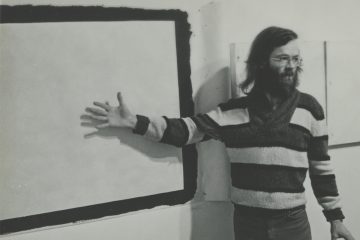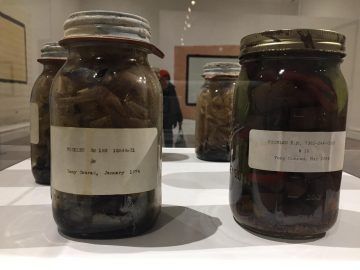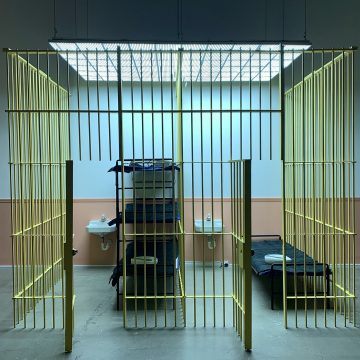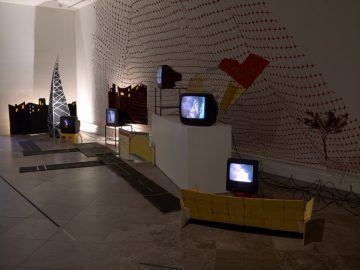by Nickolas Calabrese
 Tony Conrad’s retrospective of objects produced for galleries or institutions, titled Introducing Tony Conrad, is currently on view at the ICA Philadelphia. “Introducing” because so many people are still unfamiliar with his work. His works were predicated on both the amount of time they took to make and the patience that they required of their audience, which no doubt contributed to his lack of popularity. Conrad, the prodigal Harvard grad, spent his career working through aesthetic problems like an eccentric scientist. This can be gathered from his exhaustive lectures, teaching, and writings on sound and film. Formally, however, the works often look like a child made them. Not in a cynical way denoting lack of care, but in an earnestly amateur approach to object making. Because the works are less concerned with looking skillfully produced and more concerned with what a durational existence might impart onto things, the audience is left with big-picture questions like, what does it mean for an artwork to still be in progress after the artist’s death?
Tony Conrad’s retrospective of objects produced for galleries or institutions, titled Introducing Tony Conrad, is currently on view at the ICA Philadelphia. “Introducing” because so many people are still unfamiliar with his work. His works were predicated on both the amount of time they took to make and the patience that they required of their audience, which no doubt contributed to his lack of popularity. Conrad, the prodigal Harvard grad, spent his career working through aesthetic problems like an eccentric scientist. This can be gathered from his exhaustive lectures, teaching, and writings on sound and film. Formally, however, the works often look like a child made them. Not in a cynical way denoting lack of care, but in an earnestly amateur approach to object making. Because the works are less concerned with looking skillfully produced and more concerned with what a durational existence might impart onto things, the audience is left with big-picture questions like, what does it mean for an artwork to still be in progress after the artist’s death?
 This is best captured in Conrad’s most well-known artworks, the “infinite duration” Yellow Movies, which were painted yellow squares on paper. The idea was that they would darken and yellow with age over the course of their lifespan, thus constituting an ever-changing work, or “movie” (and for Conrad, the longest durational movie ever, putting Warhol’s Empire (1964) to shame). These works and others in the show capture his fascination with time and what it entails. The objects on view in the retrospective are largely the byproducts of experiments. Conrad, an accomplished experimental musician and filmmaker known for his vexing compositions, took his cue from thorough research into a topic, investigating the variety of forms it could take. For instance, one of the first things visitors see are a selection of handmade instruments using unorthodox materials, like a guitar made from a child’s racquet, or violin affixed to a stationary scrap-wood apparatus. Another instance is Conrad’s pickled film, which he shot and then cured in a vinegar solution in Ball jars, riffing on how film is developed in an alchemical solution.
This is best captured in Conrad’s most well-known artworks, the “infinite duration” Yellow Movies, which were painted yellow squares on paper. The idea was that they would darken and yellow with age over the course of their lifespan, thus constituting an ever-changing work, or “movie” (and for Conrad, the longest durational movie ever, putting Warhol’s Empire (1964) to shame). These works and others in the show capture his fascination with time and what it entails. The objects on view in the retrospective are largely the byproducts of experiments. Conrad, an accomplished experimental musician and filmmaker known for his vexing compositions, took his cue from thorough research into a topic, investigating the variety of forms it could take. For instance, one of the first things visitors see are a selection of handmade instruments using unorthodox materials, like a guitar made from a child’s racquet, or violin affixed to a stationary scrap-wood apparatus. Another instance is Conrad’s pickled film, which he shot and then cured in a vinegar solution in Ball jars, riffing on how film is developed in an alchemical solution.
These things carry within them the seeds of something to come, like a bet waiting to pay off. These suggest the most important feature found throughout his body of work: the effect of time. How do things exist over time? For David Hume identity was just a bundle of perceptual experiences bound together and expressed over time, tethered to and forming what we think of as a person. In this version of duration, each distinct moment, different from the last, is what comprises a thing’s sustained existence. Invoking Hume and the idea of a durational object serves two purposes. First, we should understand that these artworks, really not just Conrad’s but all artworks, are not the same when they’re conceived as whenever they’re viewed in the future. This isn’t only because of their physical aging, but also because of the social, political, ecological, etc. climate in which they are viewed in hypothetical future moments; in other words, an artwork’s meaning is relative to the context in which it is viewed. The second and more important reason is that this view provides a background for thinking about our own agency. As a lifelong educator and frequent activist, Conrad felt that it was his duty to respond to the ways that the world changed through his artworks. Being responsive to the flux of the world is each person’s responsibility, and as such the very notions of time and responsibility are necessarily linked.
 Conrad seems to suggest that duration has a moral dimension. This appears most compellingly in his Women in Prison installation and video. The piece consists of multiple jail cells with doors open, starring various friends of the artist (e.g. Tony Oursler and Mike Kelley) occupying the cells, clumsily dressed as women. Nothing exciting happens. There is also a bright light overhead that blinks on and off at regular brief intervals. Quoting Conrad in the catalog for the show, Oursler writes, “Time, Conrad explained, had a different meaning for the permanently attenuated, as did the details and routines of life. In the synthetic, denuded sphere of incarceration, little things take on great meaning…” Conrad’s prison is a lot of things: absurd, sad, funny, bleak, ridiculous. What makes the work jarring is its ambiguity. Conrad’s dark sense of humor gives the concept of imprisonment, which in other hands could have been intensely political and dry, a wry nod to the passing of time. Recall the familiar expression for incarceration: “Doing time.” If time is something that we actively do, then what is our responsibility to it? Conrad’s best counsel might be: don’t waste it.
Conrad seems to suggest that duration has a moral dimension. This appears most compellingly in his Women in Prison installation and video. The piece consists of multiple jail cells with doors open, starring various friends of the artist (e.g. Tony Oursler and Mike Kelley) occupying the cells, clumsily dressed as women. Nothing exciting happens. There is also a bright light overhead that blinks on and off at regular brief intervals. Quoting Conrad in the catalog for the show, Oursler writes, “Time, Conrad explained, had a different meaning for the permanently attenuated, as did the details and routines of life. In the synthetic, denuded sphere of incarceration, little things take on great meaning…” Conrad’s prison is a lot of things: absurd, sad, funny, bleak, ridiculous. What makes the work jarring is its ambiguity. Conrad’s dark sense of humor gives the concept of imprisonment, which in other hands could have been intensely political and dry, a wry nod to the passing of time. Recall the familiar expression for incarceration: “Doing time.” If time is something that we actively do, then what is our responsibility to it? Conrad’s best counsel might be: don’t waste it.
Conrad’s dealings with the immoral state of prison life in America was vanguard, but there are a few notable artists much younger than him who also address the problem of prisons as their chief stimulus. Cameron Rowland and Sable Elyse Smith are two who, while their works dealing with prison politics differ in tone and form from Conrad’s, trace a distinct lineage in how each are critical of what is clearly a broken model for reformation. Both Smith and Rowland use accurate accounts of prisoner’s lives in order to critique the system as a whole. However, Conrad’s critique of prisons lacks the severity present in those other works. He instead points to the absurdity of locking people up with nothing to do other than pass time. The question that they address in congress is what it means to take someone’s time. To take control of, as Hume would have it, their experiences.
 Taking stock of “little things,” Conrad uses farce to confront social control, paternalism, incarceration, and other methods of oppression. One of Conrad’s greatest works and most difficult works was his installation Panopticon (1988), a series of short narrated videos perched within a crudely built set of a city. Eponymous with Bentham’s experimental prison model, Panopticon mocks surveillance as a dull Beckettian routine. The narrator is played by Conrad himself, and the people he is listening in on are just Halloween masks. He observes them talking about shopping, dating, life’s bullshit – all while eating snacks and cackling at their foolishness. The piece is a succinct example of Conrad’s charm: this is ridiculous, let’s talk about it, laugh about it, and change it.
Taking stock of “little things,” Conrad uses farce to confront social control, paternalism, incarceration, and other methods of oppression. One of Conrad’s greatest works and most difficult works was his installation Panopticon (1988), a series of short narrated videos perched within a crudely built set of a city. Eponymous with Bentham’s experimental prison model, Panopticon mocks surveillance as a dull Beckettian routine. The narrator is played by Conrad himself, and the people he is listening in on are just Halloween masks. He observes them talking about shopping, dating, life’s bullshit – all while eating snacks and cackling at their foolishness. The piece is a succinct example of Conrad’s charm: this is ridiculous, let’s talk about it, laugh about it, and change it.
Through his consistent challenge of the authority of others, and open opposition to being a gallery artist, he was able to sustain a career built on being an innovative menace. Conrad is quoted in the press materials for the show as saying, “You don’t know who I am, but somehow, indirectly, you’ve been affected by things I did.” He is not immodest saying this. Conrad’s works were simultaneously comic and bellicose, elegant and haphazard. By throwing away the mores of what art ought to look like, he shed the normative countenance that a lot of his contemporaries held onto. One final thought: while Conrad was still alive, a younger artist who shared the same gallery as Conrad joked that Tony was the youngest artist on the roster. Given this first postmortem appraisal, Conrad is beginning to look more contemporary than ever.
